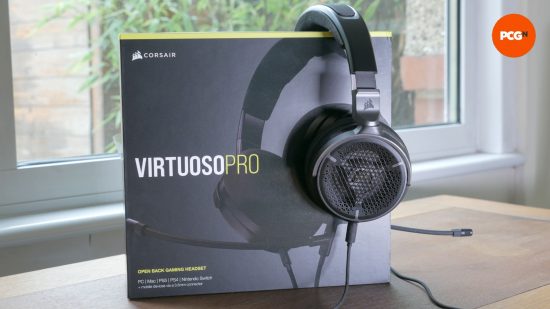Our Verdict
Superb headphone sound quality defines this gaming headset, but its microphone quality is nothing special and comfort is middling. Still, you get good value for money and the selection of cables that it provides is handy.
- Excellent headphone sound quality
- Open-back design sounds great
- Useful selection of cables
- Reasonable value
- Basic feature set
- No on-headset volume control
- Underwhelming microphone quality
- Below-par comfort levels
The Corsair Virtuoso Pro is a surprising addition to the company’s gaming headset lineup. Instead of wireless-this and RGB-that, it’s essentially just a pair of high-end open-back headphones bundled with a few cables for adding a microphone. Despite these apparent audiophile credentials, though, Corsair has slapped a reasonable price on this headset, coming in at just $200 before tax – that’s expensive but far from the most expensive gaming headset. Does it all add up to a best gaming headset contender? Let’s dig deeper.
Why you can trust our advice ✔ At PCGamesN, our experts spend hours testing hardware and reviewing games and VPNs. We share honest, unbiased opinions to help you buy the best. Find out how we test.
Specs
Corsair Virtuoso Pro specs:
Features
When we say the Virtuoso Pro is just a pair of headphones, we mean it. Apart from the wires in the box, the headset is just two 50mm drivers on stalks with a couple of 3.5mm jack sockets on each earcup to feed in the audio. Of course, there’s earcup and headband padding, but in terms of meaningful features, that’s it—no RGB, wireless, foldout microphone.
Instead, the only extra utility of this headset is provided by its three included cables. The first of these plugs into the headset’s two sockets and then into your chosen analog audio device at the other end, making a set of headphones.
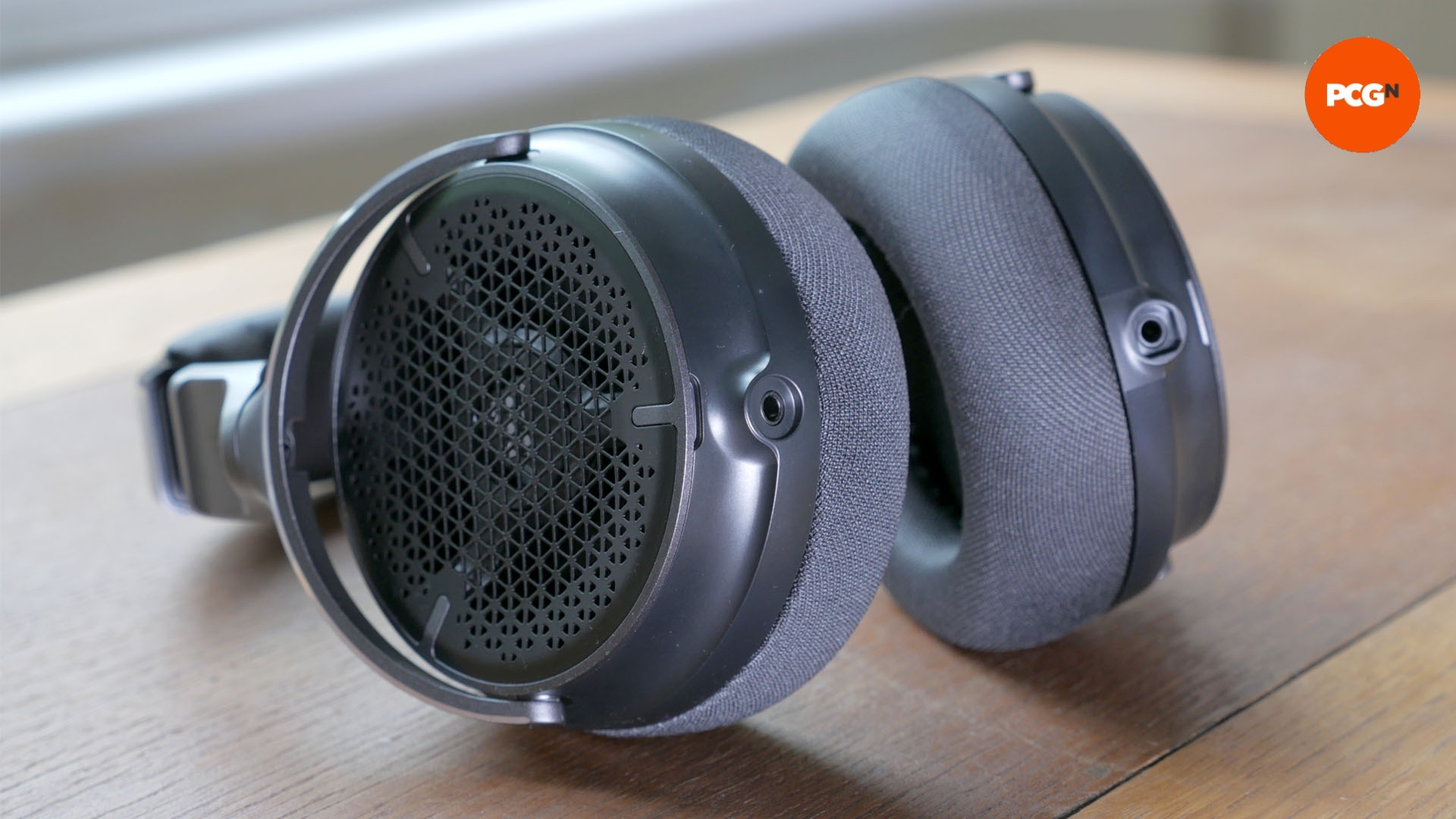
The second cable, though, includes a boom mic on the cable itself. It’s a rather clever system, as the cable slightly locks into place, which allows the flexible boom mic’s position to be easily adjusted. Moreover, a mic mute switch on the back of the cable is surprisingly easy to find and activate blindly – plenty of headsets have far trickier-to-find buttons.
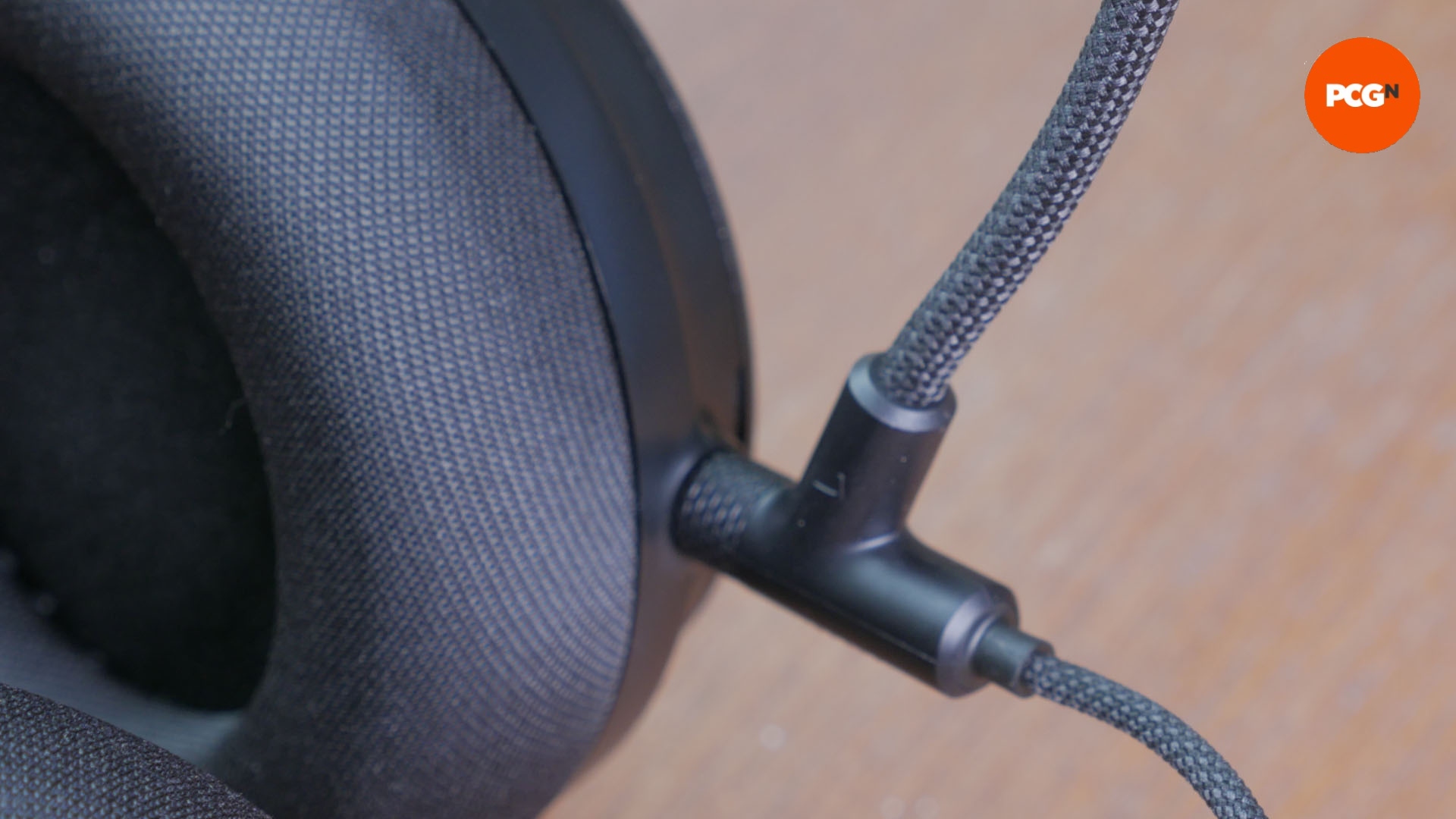
The third cable provides a Y-splitter function for the 4-pole jack plug that terminates the default microphone cable. This means you can choose not to use the splitter cable and plug the headset straight into devices with combined headphone/mic sockets, or split the signal into separate microphone and headphone signals (generally what you’d do on a desktop PC).
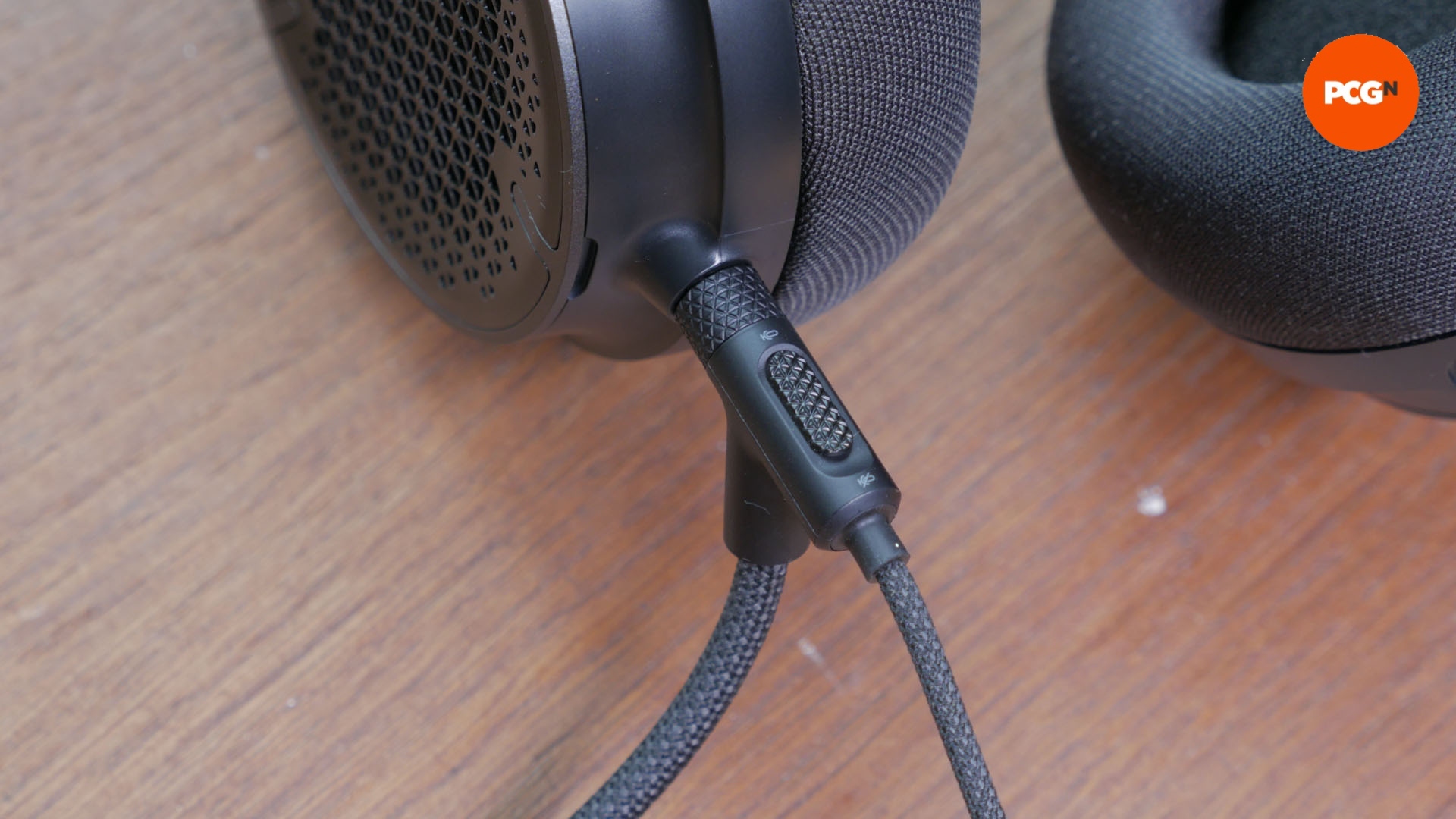
Oddly, Corsair suggests buying this headset with the Elgato Wave XLR headphone amp and mic input. This is a quality audio output that will make the most of this headset’s headphones, but the titular XLR feature is meant for use with XLR-output microphones such as the Elgato Wave DX or Shure MV7. The idea would be that you ditch the boom mic cable included with the Virtuoso Pro, and use the Wave XLR and separate mic instead. However, this suggestion also highlights how you could just as easily buy any other set of headphones with the same interface.
Meanwhile, perhaps the most notable omission of this headset is that there’s no on-headset or mid-cable volume adjustment. As a result, unless you have an on-desk audio interface with a volume control, such as the Wave XLR, you’ll have to rely on software volume control, which isn’t very convenient if you don’t have a keyboard with multimedia controls.
Design and comfort
The Virtuoso Pro has a very traditional headphone design, with a padded headband and telescoping earcup arms – as opposed to the elastic headband adjustment of the Corsair HS80 Max. The earcups also spin so you can fold them flat in one direction and turn them inwards slightly in the other direction.
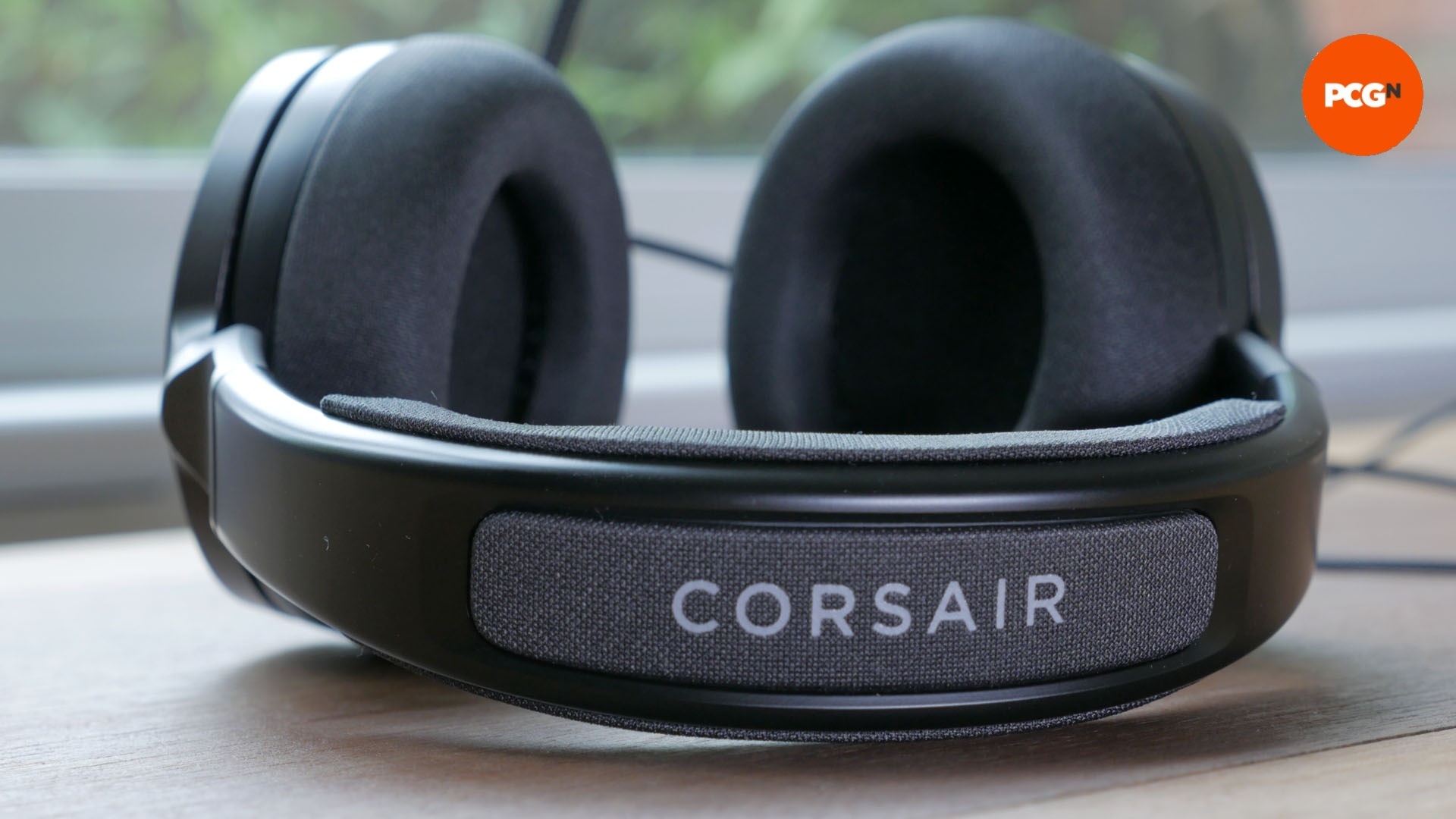
Along with that traditional design is a traditional approach to premium headphone build quality, including a metal headband spring, metal covers for the earcups, metal earcup arms, and quality-feeling fabric covers for the padded areas. The headset looks and feels good quality without a hint of garishness, and only the gaming brand association of the Corsair logo hints that these aren’t made by a more established audiophile brand. The headset is also available in a white and non-anodized aluminum finish.
However, while premium and traditional-looking, the Virtuoso Pro could take a few lessons from more modern headsets when it comes to comfort and fit. The headband is very springy, making it a touch awkward to take on and off, and this isn’t helped by the ability of the earcups to fold flat, as they can spin out your grasp, flicking the headset into your face. That’s why, unless a headset or set of headphones is explicitly meant for travel, we’ve never seen lay-flat earcups as a positive addition and prefer the only slight tilt provided by the Epos H3Pro Hybrid.
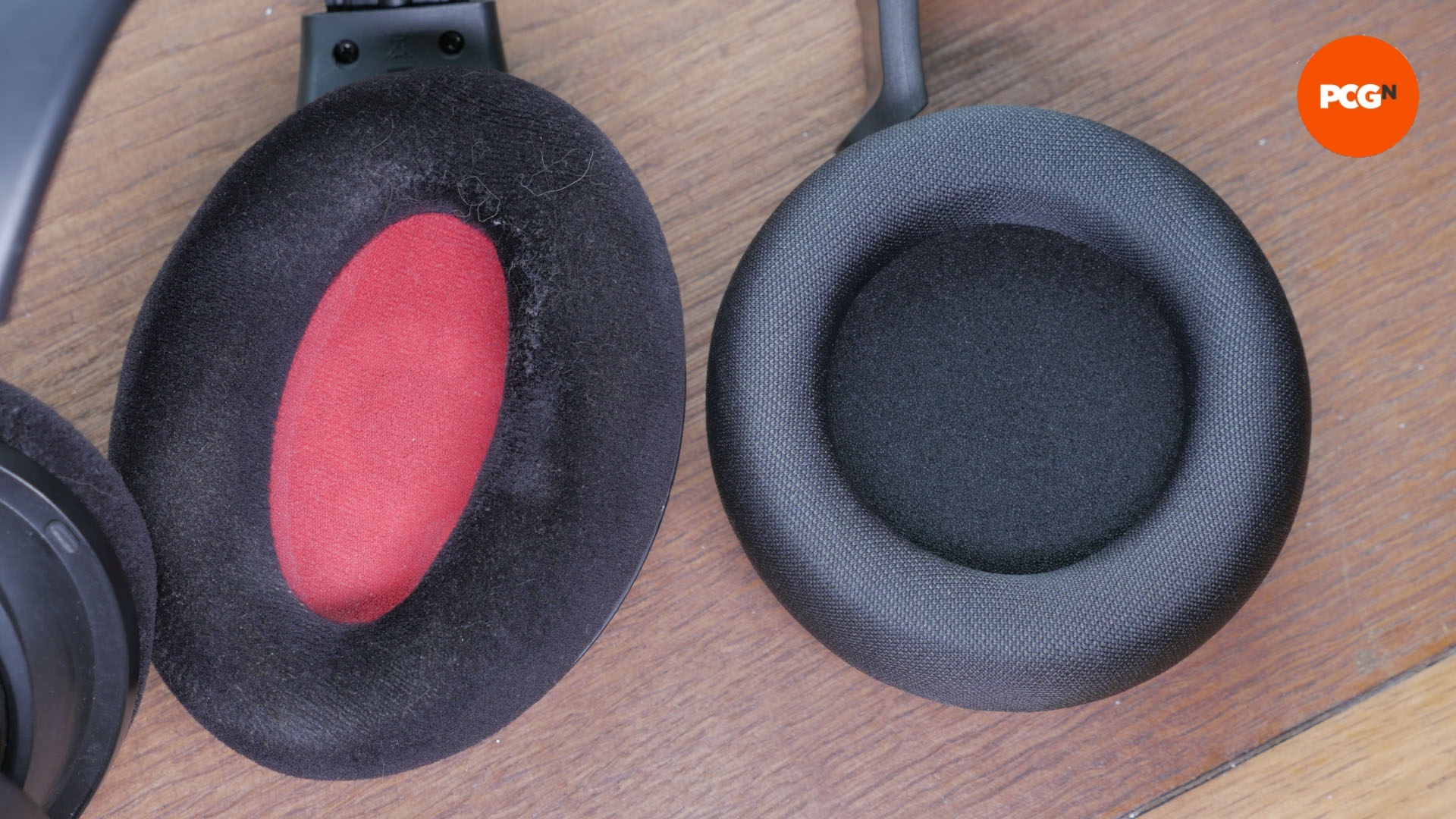
It’s a similar story with the split cable design employed here. In theory, having the two separate inputs for the earcups, and an even-length cable connecting to them, ensures the utmost signal integrity, but it does make the headset a little more awkward to handle.
Also less than stellar is the earcup comfort. The padding is soft but not particularly deep and has minimal contouring to fit around your head and ears. As such, the headset somehow feels a touch loose in terms of sliding back and forth on your ears, while also pressing on your ears – it reminds us of the almost on-ear fit of the Grado SR and RS range of audiophile headphones. Not outright uncomfortable, but not the comfiest either.
It’s a similar story with the headband padding. The band itself isn’t all that wide and the padding is shallow so it quickly becomes noticeable on the top of your head. The headset weight doesn’t help either. At 338g, it’s hardly the heaviest option – the Corsair Virtuoso RGB Wireless is 371g – but it’s a good 50-100g heavier than many top rivals.
Microphone sound quality
As highlighted earlier, Corsair recommends you buy this headset with a headphone amp that’s supposed to work with a separate dedicated microphone, which hints at the emphasis placed on the microphone quality of this headset. The included on-cable boom mic is fine for basic game chat and calls, but doesn’t have the fuller sonic range of the Epos H3Pro Hybrid or Razer BlackShark V2 Pro.
Headphone sound quality
The Virtuoso Pro hasn’t aced every test so far, but where this headset does shine is when it comes to headphone audio quality. This is certainly a quality set of headphones.
Let’s start with the open-back design, which refers to the fact that the back of the earcup behind the driver is left open instead of enclosed. As you might expect, this results in you being able to hear what’s going on around you, as sound filters largely straight through the thin driver membrane, and audio from the headphones leak out too.
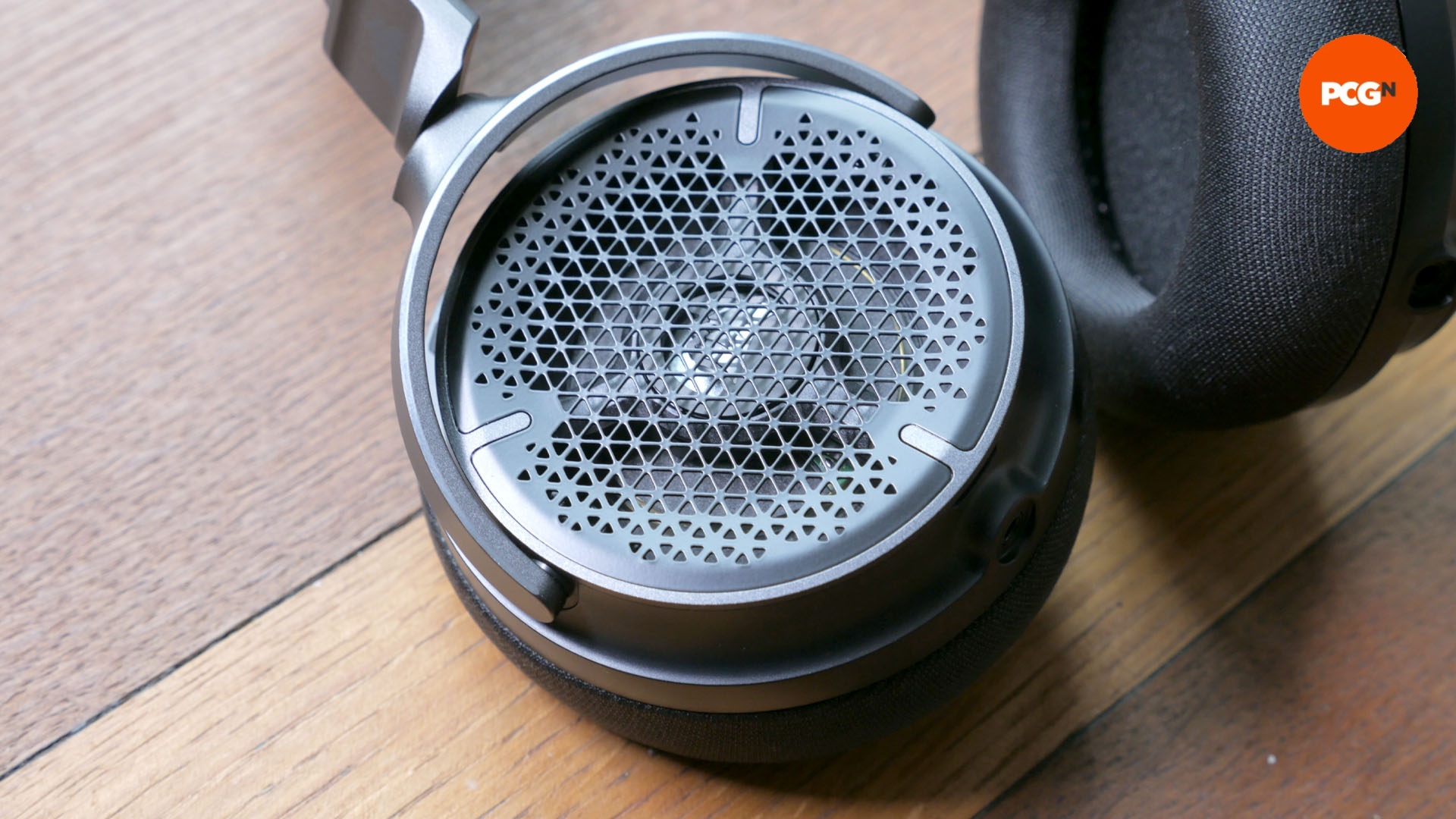
Headphone noise leaking out means you might disturb those working next to you in an open office, library, or quiet cafe, but we didn’t meaningfully find this a problem. In most realistic listening situations for home use, the audio isn’t loud enough to disturb anyone.
More of a problem will be noise leaking in, with any external noise quickly impacting your listening. While you’re unlikely to want to be drowning out plane and train noise while traveling using this headset, you may have a noisy household, a busy road nearby, or a noisy mechanical keyboard. All of those noises will mostly slip right on through.
What an open-back design loses in terms of noise isolation, though, it makes up for in soundscape, stereo image, and just about every aspect of audio listening. While so many gaming headsets can feel and sound boxy, the Virtuoso Pro envelopes you in clear sound that feels like a natural extension of the world around you, rather than being fired at you half an inch from your head.
Comparing back-to-back with the similarly open-backed Sennheiser G4ME One (there aren’t too many open-back gaming headset options), the Sennheiser headset maintains a slightly wider soundstage, but the Corsair headset still outclasses most closed-back headset designs. Interestingly, at least part of the reason for this appeared to be the Sennheiser’s deeper yet narrower (front to back) and more contoured earcups, which do a better job of directing sound consistently into your ears. The Corsair headset’s round, fairly flat earcup design means its sound can vary depending on how far forward or back the headset slides on your ears.
When it comes to overall detail levels, though, the Virtuoso Pro’s 50mm graphene drivers are in a class of their own compared to most gaming headsets. Right across their wide 20-40,000Hz frequency range, there’s excellent clarity and very little in the way of obvious sound coloring, thanks to an overly aggressive bass or treble boost.
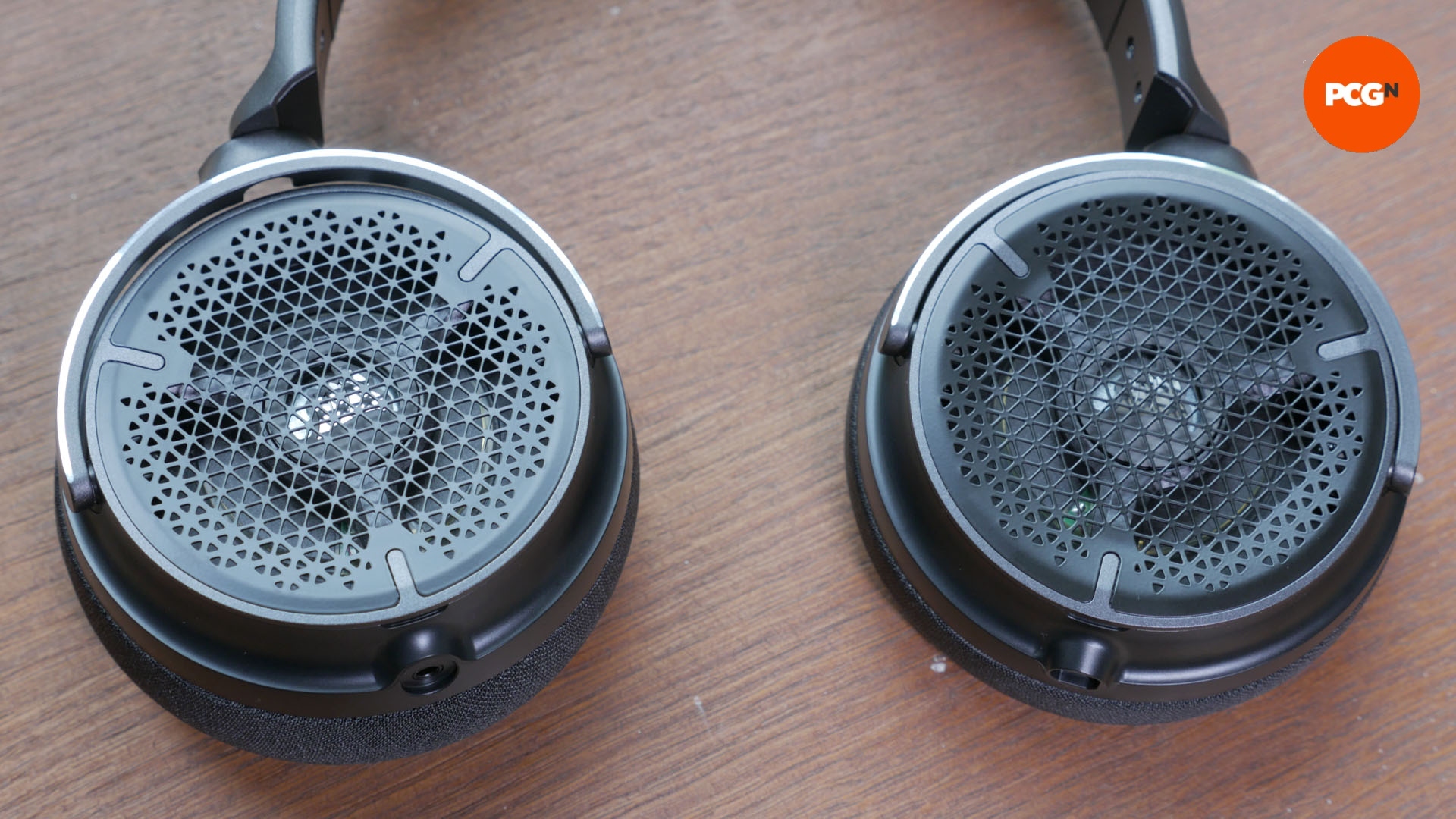
That said, sub-bass is quite strong, and while it can feel slightly forced, it generally feels smoothly integrated, adding to the sound, rather than distracting from it. As such, you can switch between delicate piano recitals or the big thumping bass of EDM tracks and not feel like the bass is coloring the former or underdelivering on the latter. There’s plenty of mid-range presence too, providing warmth and power to electric guitars and vocals, ensuring the sound profile isn’t tiring or shrill for those styles of music, as can be the case with the scooped sound profile of some headsets (with boosted bass and treble).
It’s not just music that sounds superb either, with games, movies, and more all benefitting from the broad audio range of this headset. Bombs boom, dialogue is discernible, and epic scores excite. There’s no doubt this is sonically a very accomplished headset.
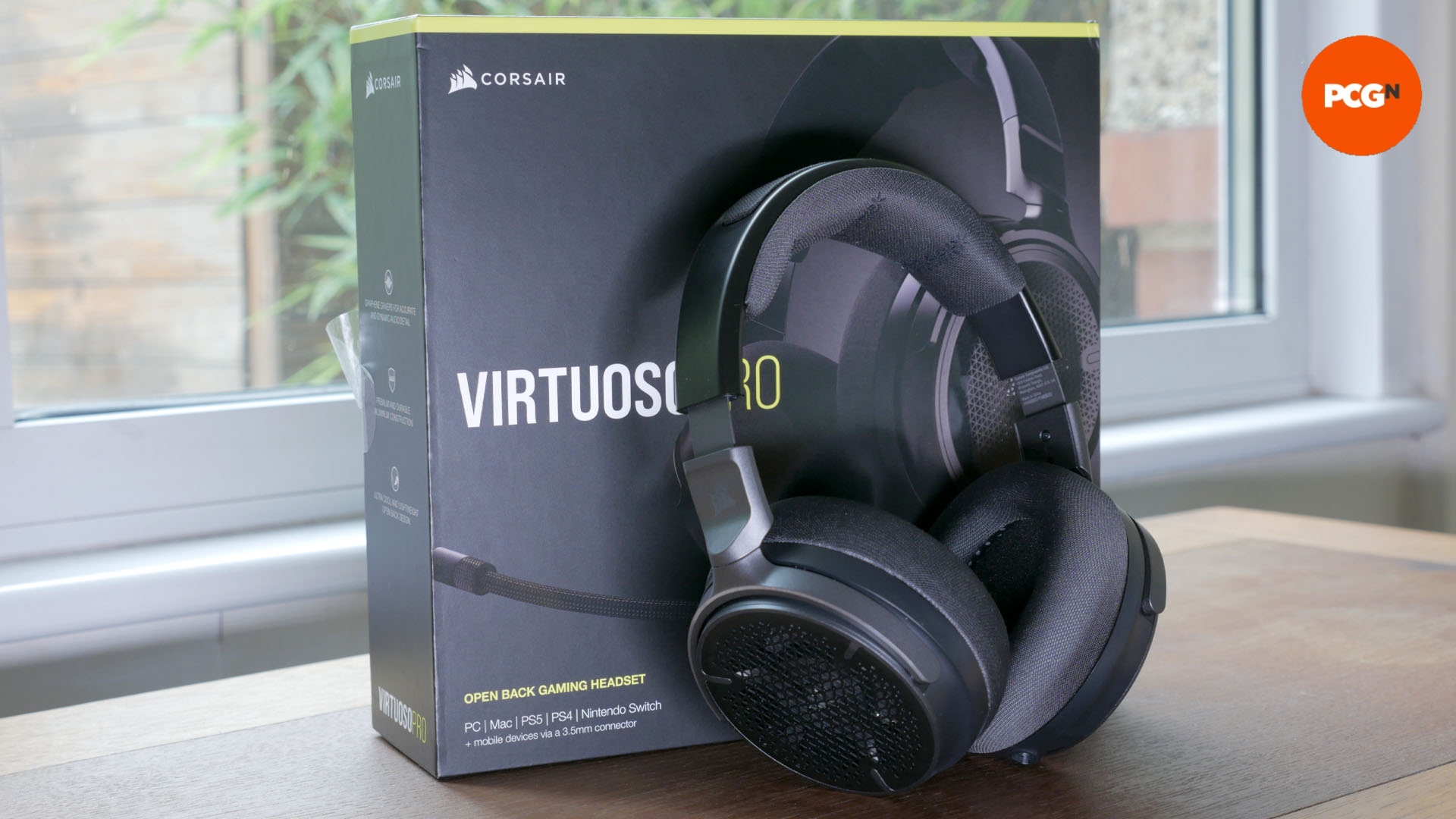
Price
The Corsair Virtuoso Pro price is $200 (£170), making it reasonably expensive, but some audiophile headsets cost much more. Just be aware that you’re paying for sound quality here, rather than features.
Conclusion
The Corsair Virtuoso Pro achieves its goal of being a gaming headset with outstanding sound quality. It delivers sparkling detail, powerful bass, and plenty of mid-range warmth, and excels at reproducing just about any sound you throw at it. The Sennheiser G4ME One gives it a close run – and it has a better soundstage – but it doesn’t have the bass power of the Corsair, so your choice here depends on what style of presentation you prefer.
Where this headset is less accomplished, though, is in the creature comforts. It’s just not a particularly comfortable headset. It’s far from the worst but there are plenty of more comfortable options, again including that old Sennheiser set.
What’s more, the fact this headset has no features seems to stretch the definition of what you can reasonably call a gaming headset. This is a set of headphones with a bundled stick-on boom mic, and a not particularly great quality mic at that.
It’s good, then, that the price is quite reasonable considering its audiophile aspirations. It’s hardly a bargain, but as high-end headphones go, it’s on the affordable end of the spectrum.
If you’re after a wireless choice, read our guide on the best wireless gaming headsets for more recommendations. Our list of the best computer speakers might also give you the sound solution you need for your setup.
